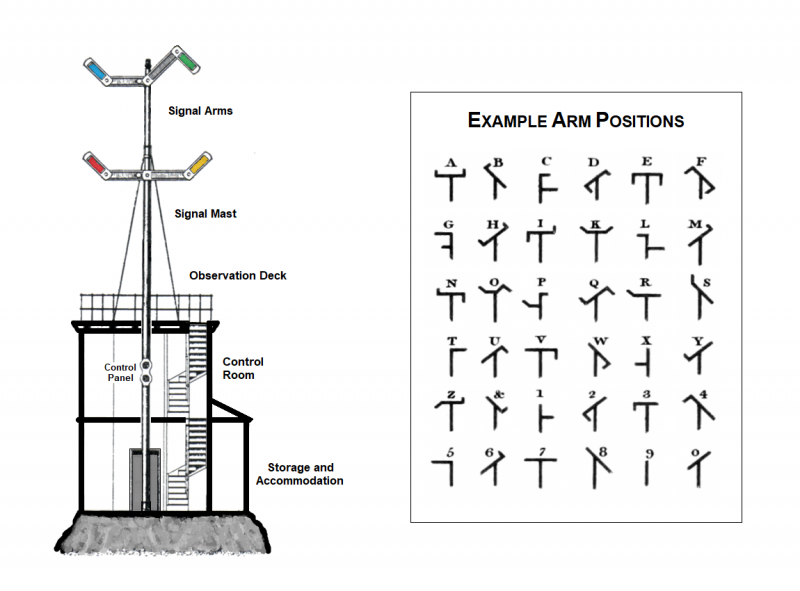Mechanical Telegraph
A Mechanical Telegraph is a machine that produces signals that can be seen from long distances.
- It is a large technological device.
- It is a type of communications equipment.
- It is a type of Telegraph that uses a Semaphore system.
- It is an example of the use of Symbols.
Description (Specifications)
A mechanical telegraph is a type of communications equipment used for signalling using Semaphore.
- It is in common usage by TL-3.
- It requires muscle-power in order to make it work (turning winding handles or moving levers on a control panel to position signalling arms).
It is a contemporary of the Electrical Telegraph
Image Repository
A schematic of a typical mechanical telegraph tower.

Function
A mechanical telegraph most commonly takes the form of a tall mast mounting a number of moveable arms.
- The mast is hollow and contains pulleys, cables, and interrupter and gearing mechanisms. These connect the signal arms to a mechanical control panel, allowing an operator to precisely set their positions.
- The mechanical controls include winding handles, pedals, levers, and indicators to show the arm positions.
- Mechanical telegraphs are often built inside a dedicated structure (such as a telegraph tower) to give additional height and stability and to protect the control equipment.
- At higher tech levels, the controls become increasingly sophisticated.
The positions of the arms signal messages to observers.
- Signal arm colors allow a greater range of signal options.
Mechanical telegraphs are often built in chains, allowing messages to be relayed between them.
- The distance to the horizon limits the distances between telegraphs in a chain.
- With skilled operators, messages may travel along relay chains at speeds of hundreds of kilometers per hour.
- A message may be targeted, only travelling between certain telegraph locations.
- Chains of telegraphs have junctions, allowing a single message to follow a particular route or allowing it to follow additional chains and reach multiple destinations.
Crew
A mechanical telegraph generally requires a crew of two:
- The operator, who controls the positions of the signalling arms using the control panel.
- An observer, who watches other telegraphs from the observation deck, notes messages, and relays messages to the operator.
The crew are skilled individuals and are required to be literate, in order to be able to read code books and record messages.
Limitations
The mechanical telegraph relies on direct observation.
- It will be rendered ineffective by smoke, by weather that reduces visibility such as fog or snow, by darkness, or by being directly blocked (for example by holding a blanket in front of the signal arm).
Mechanical telegraphs are constructed in easy to see locations such as hilltops or headlands. Local geographical changes (such as trees growing) may obscure a clear view.
- Land management may be required to keep a mechanical telegraph system functional.
- An observer may use a simple Optical Telescope to better observe distant mechanical telegraphs.
In darkness or adverse weather, mechanical telegraphs may use other means to signal simple messages, such as fiery beacons, lamps, or bells or whistles.
- The light from lamps may be filtered, with the colors displayed giving additional meaning.
- The sequence of a set of audible tones may carry additional meaning.
History & Background (Dossier)
Optical Telegraph technology is first available at TL–1
- A mechanical telegraph is a refinement of earlier technology. It uses complex mechanical components to precisely control signalling devices in order to transmit larger volumes of data quickly and efficiently.
- Mechanical telegraph systems tend to be superseded by other technological advances, such as the electrical telegraph at TL-4, telephones and radios at TL-5, and electronic equipment by TL-6.
Mechanical Telegraphs are commonly used by the military and by government agencies to convey orders, messages, and instructions over long distances.
- Law enforcement routinely use telegraphs.
- Banks and other commercial institutions regularly utilize telegraphs.
- Mechanical telegraphs often carry important items of news.
- Messages may be sent by private individuals for a small fee.
Coding and Security
Very few messages are sent in plain text. Most words and phrases are abbreviated and codes and cyphers are routinely employed.
- It is normal for the crew not to understand a word of the messages they are sending.
- It is common for identical arm positions to convey different letters or meanings, depending on the specific code being used to read them.
As an important part of communication infrastructure, mechanical telegraphs may be sited within or near military facilities and may be guarded.
- The crew of military or government-operated telegraphs are commonly drawn from military personnel.
- Commercial mechanical telegraphs may employ skilled civilian crew and private security personnel.
Messages may be recorded (commonly in big ledgers) for training and security purposes.
Transport Applications
A mechanical telegraph used with transport infrastructure.

Mechanical telegraphs are used as a means to control operations on early mass transport networks such as rail systems. These telegraphs often consist of one or more signal arms mounted on a tall mast that can either be raised (permitting the vehicle to continue onwards) or lowered (requiring the vehicle to halt).
- Signalling systems are generally operated from a remote central control room.
- Individual masts and their signal arms may be connected to the control room by kilometers of cable.
- There are usually local controls (typically a big lever on the mast) allowing the signal arm to indicate a danger that the central control room is unaware of.
References & Contributors (Sources)
- Author & Contributor: Lord (Marquis) and Master Scout Emeritus Adie Alegoric Stewart of the IISS
